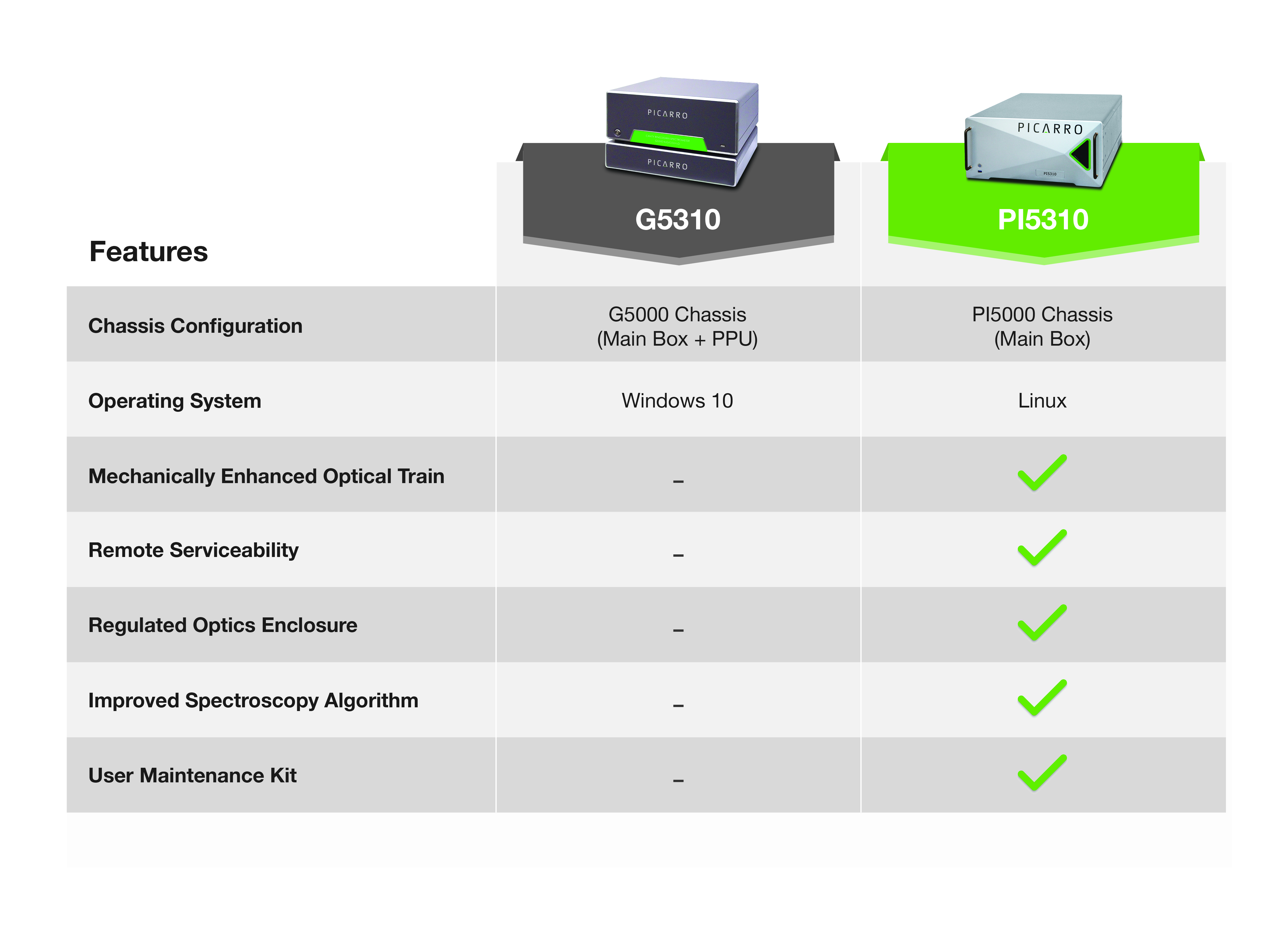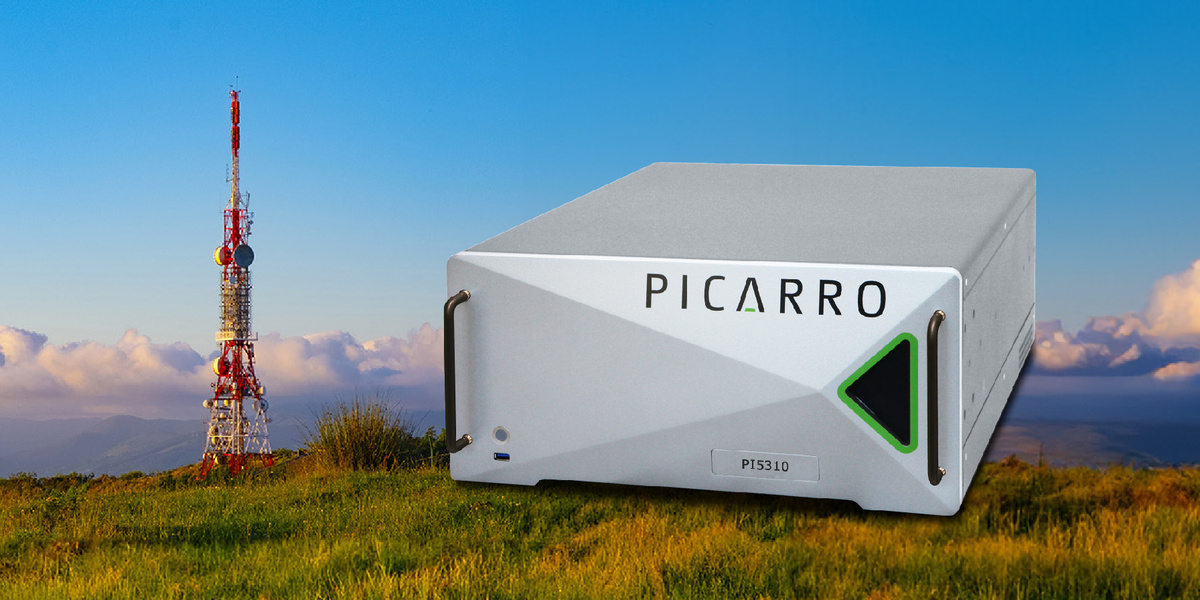In the global effort to understand and combat climate change, networks across the world are monitoring greenhouse gases (GHGs). With their unique, high-precision CRDS technology, Picarro analyzers are used in many of these networks, including at all Integrated Carbon Observation System (ICOS) Atmosphere Thematic Centre networks. With the introduction of the PI5310 Nitrous Oxide (N2O) and Carbon Monoxide (CO) analyzer, Picarro provides the best solution for N2O and CO atmospheric monitoring that meets and exceeds World Meteorological Organization (WMO) compatibility goals and ICOS specification requirements.
Why Measure N2O
Carbon Dioxide (CO2) and Methane (CH4) are often featured in the headlines for GHG discussions. Recently, the importance of N2O monitoring has been growing because of its high Global Warming Potential (GWP) which is 300 times greater than CO2 per unit mass – and its extended lifetime in the atmosphere is as long as 114 years. This means even small amounts of N2O emissions can contribute to global warming significantly and persistently for decades to come. Furthermore, it also contributes to the depletion of the ozone layer which subsequently imposes harmful threats on human health and ecosystems. To make matters worse, global atmospheric N2O concentration has rapidly increased since 1750 due to anthropogenic emissions, and we’ve seen a 15% growth rate over just the past 80 years. In response to this rising threat, several international agreements, such as the Paris Agreement and Kyoto Protocol have included N2O as one of the GHGs that signing countries are required to report as part of their commitment to the international community to reduce overall GHG emissions and achieve carbon budget goals. Specialized agencies of the United Nations are also implementing new requirements. The WMO has proposed the Global Greenhouse Gas Watch (G3W) which requires the individual model systems taking part in the G3W to deliver data on N2O abundances and net fluxes.
Challenges in Measuring Atmospheric N2O
Reporting of N2O concentrations requires accurate and spatiotemporal measurements to identify emission sources and develop effective mitigation strategies. This data often comes from the GHG monitoring networks that are set up at local, regional, and continental scales. While it sounds as simple as installing an analyzer at a monitoring station, powering it on, and collecting data, this set-and-forget scenario had remained the impossible dream for the monitoring community due to the challenges associated with quantifying N2O ambient concentrations:
- Sub-ppm atmospheric concentration: there’s only < 350 ppb N2O in the atmosphere, which is 103 times lower than CO2, so the analytical tool is required to have the precision to track sub-ppb level changes. This stringent precision requirement had traditionally been achievable only by Gas Chromatographic (GC) techniques that are slow, complex, and labor intensive to operate and maintain.
- Seasonal and spatial variability of N2O concentration requires measurements to be made in-situ and real-time. Laboratory tools like GC are no longer practical for field studies at unattended monitoring stations. Field-study deployments require infrequent calibration and long-term stability, especially for remote sites that are visited only monthly or even annually.
Why Picarro Mid-IR CRDS
To serve the needs of the GHG monitoring community for a high-precision, low-drift, and field-deployable N2O analyzer, Picarro combined our unique CRDS technology with a strong-absorption Mid-IR spectroscopy. Our CRDS technology is a time-based measurement technique that brings high stability and minimizes calibration requirements in a compact design. Our strong-absorption Mid-IR spectroscopy ensures sub-ppb precision for compounds like N2O and CO that have weak or no absorption in near-IR or visible range. With its proven WMO and ICOS network compatibility and validated best performance in N2O and CO measurements, Picarro’s first generation mid-IR analyzer G5310 has been deployed at atmospheric stations world-wide and collected years of monitoring data to help scientists better monitor the N2O concentration patterns.
Set-and-Forget N2O Monitoring with the PI5310
Picarro is thrilled to announce the launch of our brand-new PI5310 N2O and CO Gas Analyzer. Built upon the success of its predecessor G5310 and upgraded with latest innovations in mid-IR CRDS technology. The PI5310 sets the bar even higher for precision, drift, and reliability and further secures Picarro’s leading position in providing the best solution for N2O and CO atmospheric monitoring that meets and exceeds WMO compatibility goal and ICOS specification requirements. Together with its benchmark performance, the PI5310 analyzer also features upgraded hardware and software designs with enhanced remote accessibility and serviceability that advance its field deployability and make this analyzer the one and only option for conducting measurements at remote sites thousands of miles apart.
Key Upgrades:
- Superior Precision: The upgraded analyzer retains the best-in-class precision in measuring N2O and CO concentrations, with the ability to detect even the slightest changes.
- Advanced Drift Control: Optics are enclosed in a sealed box with precise temperature and pressure controls and isolated from changes in ambient environmental conditions, ensuring stable and consistent readings over extended periods of operation.
- Linux Operation System: Say goodbye to spontaneous Windows updates that restart the system and interrupt data collection.
- Enhanced Field Serviceability: Reduced service complexity and user-friendly maintenance procedures translate to optimal performance and minimal downtime in the field.
- Streamlined Operation: Simplified chassis design with one single main box to set up and operate. No special power-pump-unit (PPU) needed.
Feature Upgrade Comparison Chart of the G5310 vs PI5310

Experience the Upgrade
For more information download the PI5310 datasheet or contact our sales team at sales@picarro.com to learn more about how PI5310 can benefit your applications today.
References
1. Tian, H., Xu, R., Canadell, J.G. et al. A comprehensive quantification of global nitrous oxide sources and sinks. Nature 586, 248–256 (2020). https://doi.org/10.1038/s41586-020-2780-0
2. Garthwaite, J. Stanford expert explains why laughing gas is a growing climate problem. Stanford News, October 7, 2020. https://news.stanford.edu/2020/10/07/laughing-gas-growing-climate-problem/
3. Greenhouse Gas concentrations hit record high. Again. WMO Media Release. November 15, 2023. https://wmo.int/news/media-centre/greenhouse-gas-concentrations-hit-record-high-again
4. Global Greenhouse Gas Watch. WMO Magazine Article. May 5, 2023. https://wmo.int/media/magazine-article/global-greenhouse-gas-watch
5. Balslev-Clausen, D., Farinas, A., Van Pelt, A. et al. A mid-IR, wavelength-scanned, cavity ring-down spectrometer for continuous trace N2O and nitrogen isotope measurements. ICDC8 2009. https://www.picarro.com/support/literature/mid-ir-wavelength-scanned-cavity-ring-down-spectrometer-continuous-trace-n2o-and
6. Zellweger, C., Steinbrecher, R., Laurent, O. et al. Recent advances in measurement techniques for atmospheric carbon monoxide and nitrous oxide observations. Atmospheric Measurement Techniques, 12, 5863-5878, 2019.
